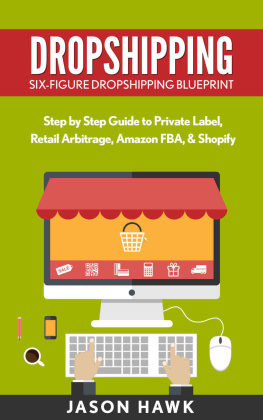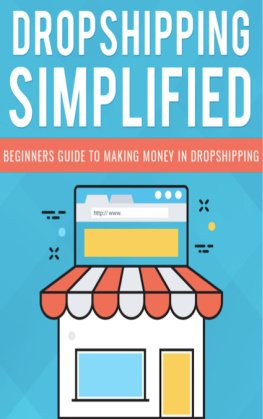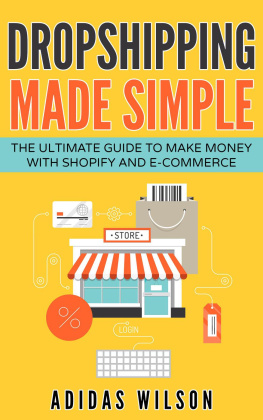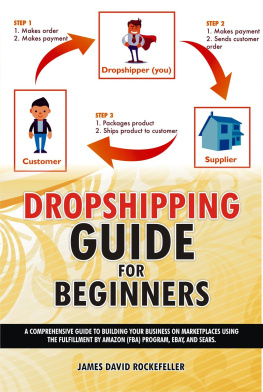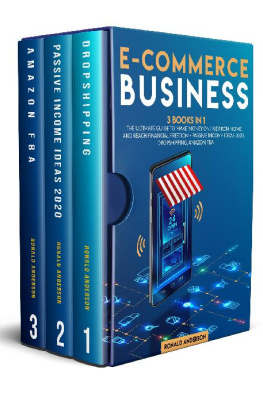Dropshipping:
Six-Figure Dropshipping Blueprint:
Step by Step Guide to Private Label, Retail Arbitrage, Amazon FBA, Shopify
Copyright 2016 - All rights reserved.
In no way is it legal to reproduce, duplicate, or transmit any part of this document in either electronic means or in printed format. Recording of this publication is strictly prohibited and any storage of this document is not allowed unless with written permission from the publisher. All rights reserved.
The information provided herein is stated to be truthful and consistent, in that any liability, in terms of inattention or otherwise, by any usage or abuse of any policies, processes, or directions contained within is the solitary and utter responsibility of the recipient reader. Under no circumstances will any legal responsibility or blame be held against the publisher for any reparation, damages, or monetary loss due to the information herein, either directly or indirectly.
Respective authors own all copyrights not held by the publisher.
Legal Notice:
This book is copyright protected. This is only for personal use. You cannot amend, distribute, sell, use, quote or paraphrase any part or the content within this book without the consent of the author or copyright owner. Legal action will be pursued if this is breached.
Disclaimer Notice:
Please note the information contained within this document is for educational and entertainment purposes only. Every attempt has been made to provide accurate, up to date and reliable complete information. No warranties of any kind are expressed or implied. Readers acknowledge that the author is not engaging in the rendering of legal, financial, medical or professional advice.
By reading this document, the reader agrees that under no circumstances are we responsible for any losses, direct or indirect, which are incurred as a result of the use of information contained within this document, including, but not limited to, errors, omissions, or inaccuracies.
Contents
Introduction
Chapter 1 What is Dropshipping and How Does It Work?
Chapter 2 Understanding Dropshipping
Chapter 3 - The Blueprint
Chapter 4 Getting Your Own Dropshipping Business Off the Ground
Chapter 5 Choosing the Right Products
Chapter 6 Choosing the Right Supplier
Chapter 7 The Risks and Pitfalls of Dropshipping
Conclusion
Introduction
Making money online has never been easier. Once upon a time, you would have had to spend a vast fortune on setting up a website, domain names and hosting, buying in and storing vast amounts of stock and all the hassle of filling and shipping the orders. The advent of dropshipping takes care of all that by taking the hassle and the hard work out of your hands and sending the money rolling into your bank account overnight.
Dropshipping is a fulfillment model that enables you to purchase products individually from a manufacturer, wholesaler, or other supplier and ship them directly to your customer. This means that instead of selling goods to your customer in a traditional way, where you would purchase the stock and ship it to your customer from your warehouse, you can expedite the process and have it shipped directly to your customer from the supplier's warehouse.
In a nutshell, dropshipping provides you with a way to become a middleman, a way of selling to the public without actually holding on to any stock whatsoever. The risks are much lower; all you need to do is find the suppliers, advertise the goods, and send your orders to the supplier. They send you the difference between the charge for their product and the price you sell for, allowing you to make money easily with the minimum amount of risk and work.
Dropshipping is by no means a new scheme; it was in use in one way or another long before the internet was born. The internet just makes it much easier, faster, and opens up the market to more people.
If you want to learn all about dropshipping and how you can earn money easily, youve come to the right place. Thank you for downloading my book; I hope you find it useful.
Chapter 1 What is Dropshipping and How Does It Work?
Dropshipping is a method by which you, as a retailer, sells products to the public without actually holding on to any stock or product. When you sell a product, you send the order directly to your chosen supplier; they ship the product, process the payment, and then send you the difference between the charge they make for the product and the price you charge. You never see the product, you never handle it and you dont need to handle or process any payments. While you dont need to handle the payments, there are some suppliers that will allow you to process your own payments and even some that will allow you to contract your own shipping company. Utilizing these choices, however, defeats the purpose of choosing to run your business using dropshipping.
There are many differences between a normal ecommerce business and a business using the dropshipping model. Some of those differences include the operating margins, operational logistics, operational costs, profit velocity, and barriers to entry. Below we are going to cover each of the differences individually.
Operating Margins : The operating margin is the ratio that is used to measure a companys pricing strategy and operating efficiency. It is the measurement of the proportion of the companys revenue that is left over after paying for variable costs of production. The operating margin for a company that uses dropshipping is always going to be lower than that of a typical ecommerce company because you dont have the burden of carrying inventory or shipping product.
Operational Logistics : If you are running a business using dropshipping, you dont need to carry any inventory or ship any products, which gives you the freedom to run your store from virtually anywhere in the world. When you are running a typical ecommerce store, you need to consider the logistics of running a warehouse and replenishing your stock, as well as coordinating shipping.
Operational Costs : If you are running a traditional ecommerce business you must consider the cost of paying for your warehouse, paying for the staff to run your warehouse, paying for the stock, shipping, and handling customer service. In comparison, the cost of running a business using the dropshipping method is limited to just customer service to take orders and send them on to the wholesaler or manufacturer.
Profit Velocity : While the hands-off nature of dropshipping is incredibly attractive from an operational standpoint, carrying inventory is a much faster way to ramp up profitability. This is because the profit margins are much higher when you have the option of purchasing product in bulk from an overseas suppliers and selling them at a higher cost.
Barriers to Entry : Barriers to entry include the existence of high start-up costs and the other obstacles that prevent a new competitor from entering an industry. A company that is using dropshipping is a lot easier to copy and start up than a company that carries and ships its own stock.
A Real World Example
Lets assume that you choose to sell guitars. With a traditional store, you would need to buy in physical stock so you buy 25 guitars and store them. Then you would need to find customers who want to purchase the guitars. Lets say that you sell 3 guitars and then sales drop off. You go out of business and end up with a room full of guitars that you cant sell and no money in your bank account. With dropshipping, life is much easier:
You set up a website with an online store to sell guitars.
You sell a Silver Shadow guitar for $350
You receive an order for one Silver Shadow through your online store
That order is sent to your supplier the manufacturer or wholesaler that you have chosen

